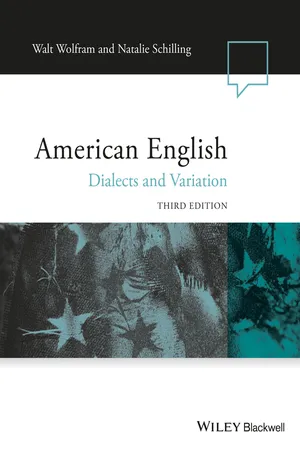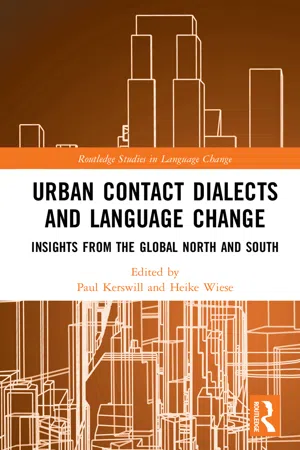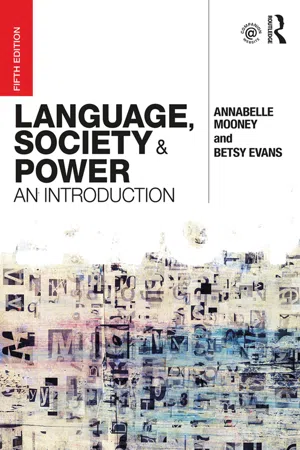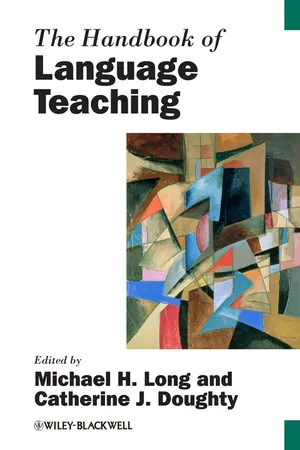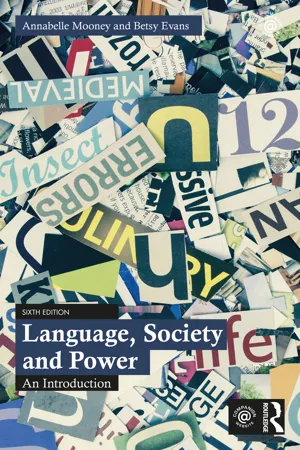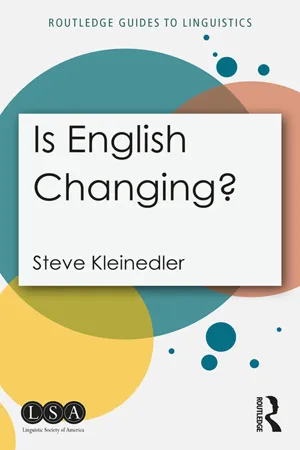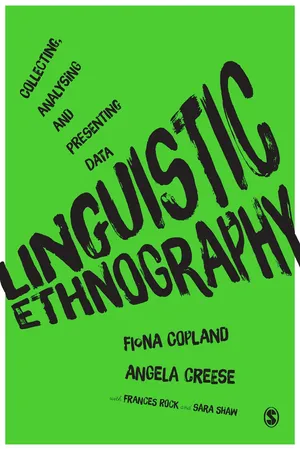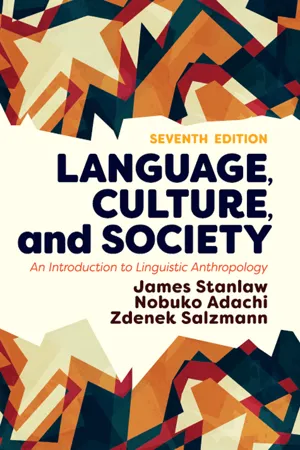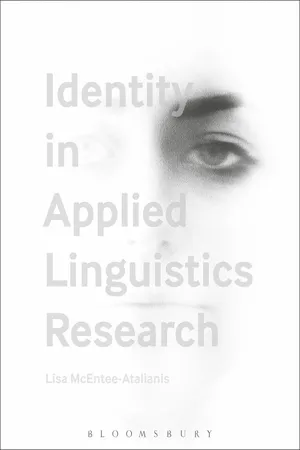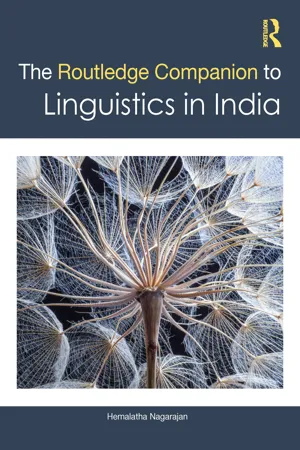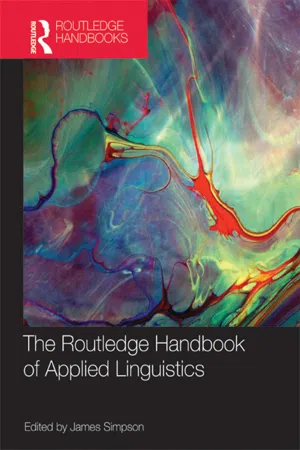Languages & Linguistics
Ethnolect
Ethnolect refers to a variety of language or dialect associated with a particular ethnic group or community. It encompasses the distinct linguistic features, vocabulary, and pronunciation patterns that are characteristic of a specific cultural or ethnic background. Ethnolects can develop within multicultural societies and are influenced by factors such as immigration, social identity, and intercultural communication.
Written by Perlego with AI-assistance
12 Key excerpts on "Ethnolect"
Learn about this page
Index pages curate the most relevant extracts from our library of academic textbooks. They’ve been created using an in-house natural language model (NLM), each adding context and meaning to key research topics.
- eBook - ePub
American English
Dialects and Variation
- Walt Wolfram, Natalie Schilling(Authors)
- 2015(Publication Date)
- Wiley-Blackwell(Publisher)
The situations described in this chapter represent only a few of the different ways in which language variation can link to ethnicity. Although it does not stand alone as a variable, ethnic-group affiliation can be one of the most powerful factors in constructing and sustaining distinctive varieties of English. This will be further demonstrated in our discussion of the language varieties of African Americans in the next chapter.Exercise 7.3
Select three of the five ethnic varieties detailed above and compare them in terms of (1) sociohistorical setting, (2) heritage language background, (3) relationship to regional varieties, (4) distinctive linguistic traits, and (5) ways in which ethnolinguistic varieties are sociopolitically embedded.7.8 Further Reading
- Benor, Sarah Bunin (2010) Ethnolinguistic repertoire: Shifting the analytic focus in language and ethnicity. Journal of Sociolinguistics 14: 159–183. This important article urges researchers to consider alternatives to the notion of Ethnolect and ethnic variety as traditionally delimited in studies of language and ethnicity. Benor maintains that speakers select from a resource pool of linguistic features that index ethnicity rather than adopt a variety with a bounded set of linguistic structures.
- Benor, Sarah Bunin (2012) Becoming Frum: How Newcomers Learn the Language and Culture of Orthodox Judaism. New Brunswick: Rutgers University Press. In this book, based on extensive ethnographic and sociolinguistic research, the author explains how newcomers learn Orthodox Jewish culture through their interactions with community members. The book also includes the most comprehensive current description of linguistic traits associated with Jewish American English.
- Chun, Elaine (2004) Ideologies of legitimate mockery: Margaret Cho’s revoicings of mock Asian. Pragmatics 14: 263–289. An excellent overview of Mock Asian as well as the way it can be recontextualized in performance to ridicule the stereotyping and marginalization of Asian Americans.
- Dubois, Sylvie, and Barbara M. Horvath (1998) From accent to marker in Cajun English: A study of dialect formation in progress. English World-Wide
- eBook - ePub
Urban Contact Dialects and Language Change
Insights from the Global North and South
- Paul Kerswill, Heike Wiese, Paul Kerswill, Heike Wiese(Authors)
- 2022(Publication Date)
- Routledge(Publisher)
Cheshire and Fox 2009 ). On the whole, however, a good deal of the earlier research on multiEthnolects compares the speech of the local (White) population with that of a bundle of non-local immigrant ethnicities (e.g. ‘Non-Anglo’ in the MLE research), rather than teasing ethnic identity apart.What the research presented in this volume and elsewhere shows is that ‘inter-ethnic’ fused dialects emerge when their speakers routinely interact, share strong, dense, close-knit social network ties and belong to the same communities of practice. Central to the emergence and focusing of the ‘multiEthnolect’ then is social network membership and not ethnicity per se. Some members of an ethnic group may not be part of that network (and so may adopt features from the multiEthnolect late or not at all). Some networks might form, which, because of neighbourhood demographics, housing policy, migration history and so on, bring people together with a varied but nevertheless restricted set of ethnic backgrounds. Important to tease apart, then, is the extent to which ethnicity is the central determinant of the emergence of the multiEthnolect, or actually the structure of social network ties in certain communities which happen to be multiethnic.6 Are multiEthnolects special?
The sociolinguistics of ethnicity has been at the forefront of our empirical and theoretical attention in sociolinguistics over the past two decades. The 21st century has brought a range of studies of Ethnolects of different kinds as we have seen – of the fused multiEthnolects of Northern and Western European cities as well as of those of individual migrant communities in North America, Australasia and beyond. Much of the retheorisation of dialect as a repertoire of linguistic resources from which speakers draw in light of the particular indexical meanings attached to them stems from research with ethnicity as its focus (Benor 2010; Sharma 2011 - eBook - ePub
Language, Society and Power
An Introduction
- Annabelle Mooney, Betsy Evans(Authors)
- 2018(Publication Date)
- Routledge(Publisher)
Section 9.6 ) in sociolinguistic research has already drawn attention to the way identity is emergent and constructed through interaction with others in particular circumstances. As such, it may be that superdiversity overlaps in many respects with the ways that diversity has been addressed in the field in previous years (see also Pavlenko, 2017).7.10 SummaryLanguage can be used to demonstrate or claim an ethnicity. However, because the link between language and ethnicity is not straightforward, any claims to an ethnicity may be challenged. Such a challenge may be directly posed by an ‘authentic’ member of the group. The claim may also not be acknowledged because of lack of understanding of the linguistic features and semiotic resources used to signal ethnicity. Further, what looks like a claim to ethnicity may in fact be something else, as we saw in the case of crossing. How claims are made, how ethnicity is performed, depends on the local context, including the interactional situation, and the features available for exploitation. Moreover, it is important to consider the range of features a speaker relies on, as it may be the use of a specific combination of features that makes the claim to ethnicity and identity. Being able to use a linguistic variety brings with it cultural capital. In the case of Ethnolects, this might be minimal because of linguistic subordination. In addition, linguistic subordination also means that Ethnolects are disparaged and misunderstood and result in speakers being vulnerable to a variety of risks that can be more or less serious.Notes
1 This was a popular stage show that toured in Australia in the 1990s.2 A kind of Panjabi music.Further Reading
Albury, N. J. (2017) Mother tongues and languaging in Malaysia: Critical linguistics under critical examination, Language in Society , 46(4): 567–589.Allport, G. (1954) The Language of Prejudice, in The Nature of Prejudice . Boston: Beacon Press.Cheshire, J., Kerswill, P., Fox, S., and Torgensen, E. (2011) Contact, the feature pool and the speech community: The emergence of Multicultural London English, Journal of Sociolinguistics , 15(2): 151–196.van Dijk, T. (2004) Racist discourse, in Cashmere, E. (ed.) Routledge Encyclopaedia of Race and Ethnic Studies - eBook - ePub
- Michael H. Long, Catherine J. Doughty, Michael H. Long, Catherine J. Doughty(Authors)
- 2011(Publication Date)
- Wiley-Blackwell(Publisher)
Studies on code-switching have illustrated the regularity of code-switching behavior and the purposes that code-switching can serve for bilinguals. Given the many contexts today where English is used as one of the additional languages within a country, more research is needed regarding how individuals make use of English in reference to the other languages they speak. Such research will be valuable in establishing classroom objectives that complement the students’ use of English within their own speech community. In addition, in classrooms in multilingual contexts where the teacher shares a first language, more research is needed to determine how students’ first language can be used to further their competence in a target language.Ethnographic sociolingistics
A good deal of current work in sociolinguistics falls under what is referred to as an ethnomethodologically oriented approach to the field of sociolinguistics, with linguistic interaction as the focal point. One of the central concepts of ethnographic or interactional sociolinguistics is the term speech community. Hymes (1972) contends that members of a speech community must share the same rules of speaking and be familiar with at least one common linguistic variety. Individuals are typically members of several speech communities and alter their norms of language use to conform to other members of the same speech community. With growing mobility, individuals today can belong to many different speech communities.Work in linguistic interaction began as a reaction to Chomsky’s (1957) focus on the language of an idealized speaker-listener in a homogeneous speech community with complete knowledge of the language. This notion was challenged by Hymes (1974), who insisted that studies on language use should strive to account for the communicative competence of a native speaker of a language. Gumperz (1982) also challenged Chomsky’s notion of an idealized speaker in a homogeneous speech community, arguing instead that language use in a speech community is influenced by social and cultural factors. Gumperz’s studies on communication between blacks and whites in the United States and between Indians and British in England demonstrated how differences in language use among speech communities can cause misunderstandings leading to racial and ethnic stereotypes and inequalities in power. - eBook - ePub
Language, Society and Power
An Introduction
- Annabelle Mooney, Betsy Evans(Authors)
- 2023(Publication Date)
- Routledge(Publisher)
Chapter 1 , variation in language is typically defined in terms of deviation from the hegemonic norm, or ‘standard’ language. Thus, when we describe linguistic variation, we can frame it not in terms of ‘deviation from the standard’ but rather in terms of selection of linguistic features from a repertoire to signal a particular identity.We also described in Chapter 1 that speaking the ‘standard’ variety of a language confers prestige in wider society, and some linguists describe this as ‘overt prestige’ (Labov, 1972a ): high status awarded to varieties that are valued according to hegemonic norms. Members of groups whose varieties are not valued by wider society are not unaware of the disdain wider society has for their variety. This awareness of the stigma of their own variety is referred to as ‘linguistic insecurity’ (Labov, 1966 ) and is related to ‘internal racism’ (Charity Hudley, 2017 : 382). Nevertheless, members of these communities find their repertoires invaluable for expressing their identities regardless of hegemonic norms. Recognising that power and prestige can take different forms in different contexts clearly matters. These features of the ethnolinguistic repertoire relate directly to the ‘linguistic push-pull’ that Rahman (2008) refers to, whether in an in-group context or across groups. We’ll see this in more detail in Section 7.4.2 .7.4.1 Ethnolect or Repertoire?
In New Zealand, the two main ethnic groups are Europeans (Pakeha) and indigenous Māori (te tangata whenua). English, however, is the dominant language for both groups, in that it is the most commonly used. D’Arcy (2010) - eBook - ePub
- Steve Kleinedler(Author)
- 2018(Publication Date)
- Routledge(Publisher)
Society and culture
Each of the previous chapters was an overview of a linguistic subfield and examined how English has changed in that subfield.7.0 IntroductionThis chapter deals with SOCIOLINGUISTICS , the study of the influence of society and culture on language, including the way society and culture cause language change. Sociolinguists analyze the phonological, morphological, syntactic, semantic, or pragmatic features of one or more social groups (such as ones categorized by gender, economic class, race, ethnicity, or age). Some sociolinguists document how these linguistic features are manifested in the speech of a particular social group, others compare and contrast similarities and differences across multiple groups, still others document linguistic changes that certain groups innovate.Obviously, no social or cultural group is a monolithic entity. The phonological features of the working class in Pittsburgh are different from those of the working class in Manchester, Baltimore, or Adelaide, and these phonological features change over time.REGIONAL VARIATION (also called DIALECTOLOGY ) is the study of how a language varies from region to region. For languages spoken worldwide like English, the analysis can be global or within a country: for example, documenting a variety of English spoken in the bayous of Louisiana, or comparing English spoken in southwestern England to that of Yorkshire.7.1 Language and varietyImagine two people speaking to each other. Could you tell if they’re speaking the same language, different dialects of the same language, or different languages? Let’s examine what this question means. - eBook - ePub
Linguistic Ethnography
Collecting, Analysing and Presenting Data
- Fiona Copland, Angela Creese(Authors)
- 2015(Publication Date)
- SAGE Publications Ltd(Publisher)
One Linguistic EthnographyIntroduction
Linguistic ethnography is an interpretive approach which studies the local and immediate actions of actors from their point of view and considers how these interactions are embedded in wider social contexts and structures. According to Erickson (1990: 92), interpretive approaches are necessary because of the ‘invisibility of everyday life’ which when held at arms-length can empirically serve ‘to make the familiar strange’. This contrasts with the approach which anthropology traditionally adopted which was ‘to make the strange familiar’. Whereas the former requires we examine the institutions and social practices surrounding us in contemporary life, the latter looked to describe the exotic, unknown other to make sense of the daily existences of people in distant places. To make the familiar strange, we need the interpretive approaches of linguistic ethnographers because the institutions we know best, the routines we practice most, and the interactions we repeatedly engage in are so familiar that we no longer pay attention to them. Yet these contexts, very close to hand, contain fundamental questions about communication in a rapidly changing world which can benefit from a combined examination of language and cultural practices. Put simply, a shared interest in social and linguistic processes means a commitment to answering the questions, ‘What is it about the way we use language that has an impact on social processes? What is it about social processes that influences linguistic ones?’ (Heller, 1984: 54).The necessity of looking in ‘our own backyard to understand shifting cultural meanings, practices and variations’ (Rampton, 2007a: 598) has been well made in ethnography. Heller (2008: 250) points out:Ethnographies allow us to get at things we would otherwise never be able to discover. They allow us to see how language practices are connected to the very real conditions of people’s lives, to discover how and why language matters to people in their own terms, and to watch processes unfold over time. They allow us to see complexity and connections, to understand the history and geography of language. They allow us to tell a story; not someone else’s story exactly, but our own story of some slice of experience, a story which illuminates social processes and generates explanations for why people do and think the things they do. - eBook - ePub
Language, Culture, and Society
An Introduction to Linguistic Anthropology
- James Stanlaw, Nobuko Adachi, Zdenek Salzmann(Authors)
- 2018(Publication Date)
- Routledge(Publisher)
idiolect. Almost all speakers make use of several idiolects, depending on the circumstances of communication. For example, when family members talk to each other, their speech habits typically differ from those any one of them would use in, say, an interview with a prospective employer. The concept of idiolect therefore refers to a very specific phenomenon—the speech variety used by a particular individual.DIALECTSOften, people who live in the same geographic area, have similar occupations, or have the same education or economic status speak relatively similar idiolects compared to those from other groups. These shared characteristics may entail similarities in vocabulary, pronunciation, or grammatical features. When all the idiolects of a group of speakers have enough in common to appear at least superficially alike, we say they belong to the same dialect. The term dialect, then, is an abstraction: It refers to a form of language or speech used by members of a regional, ethnic, or social group. Dialects that are mutually intelligible belong to the same language. All languages spoken by more than one small homogeneous community are found to consist of two or more dialects.Mutual intelligibility, of course, can vary in degree. In the early 1950s, a number of men and women from eight reservations in New York and Ontario were tested in an experiment designed to determine which of their local dialects were mutually intelligible and therefore dialects of one language, and which were not and therefore could be classified as individual languages of the Iroquoian language family. Even though the investigators arrived at percentages of intelligibility between any two of the Iroquoian speech communities, the question of where the boundaries lay between intelligibility and unintelligibility remained unresolved. If the boundaries between language and dialect had been drawn at 25 percent of mutual intelligibility, there would have been four different languages, of which one would have consisted of two dialects and another of three. If set at 75 percent, there would have been five languages, two of which would have consisted of two dialects each. - eBook - ePub
- Lisa McEntee-Atalianis(Author)
- 2018(Publication Date)
- Bloomsbury Academic(Publisher)
Sociolinguistic researchers (as discursive psychologists) adopting social interactional approaches argue that ethnic and religious identity cannot be abstracted from concrete social practices. Research (beyond that discussed in the section ‘Ethnolects and ethnolinguistic repertoires’ above) has focused on the linguistic resources employed by speakers to project and shape ethnic identity in ongoing talk. For example, Schilling-Estes (2004) combines variationist quantitative analysis with CA in her investigation of a triethnic community in southeastern United States, showing how two informants appropriate linguistic features to shape and reconfigure (inter)-personal and group identity. In so doing, they orient to their ethnic identities but also mark ethnic distance between one another. The study finds that despite slight shifts in identity performance, the two informants also display relatively fixed ethnic identities (that of ‘Lumbee’ and ‘African American’), and this stability is marked by the ethnolinguistic patterns displayed in their speech (assessed quantitatively). These findings contribute to an understanding of the relationship between and the constraints imposed by agency versus social institutions.Sociolinguistic research has also identified the relationship between speech community/Community of Practice membership, CS and the discursive construction of ethnic identity. De Fina (2007) combines ethnographic observation with CA in an analysis of the construction of Italian ethnicity in interactions between members of an all-male card playing club. She identifies CS as fundamental to the building of a collective identity among the group and notes that switching into Italian is particularly important in the execution of particular practices, notably socialization practices in relation to the game being played (see Extract 5) and in the official discourse used by the club president to his membership. - eBook - ePub
Language, Society and Power
An Introduction
- Annabelle Mooney, Betsy Evans(Authors)
- 2018(Publication Date)
- Routledge(Publisher)
Section 9.6 ) in sociolinguistic research has already drawn attention to the way identity is emergent and constructed through interaction with others in particular circumstances. As such, it may be that superdiversity overlaps in many respects with the ways that diversity has been addressed in the field in previous years (see also Pavlenko, 2017).7.10 SummaryLanguage can be used to demonstrate or claim an ethnicity. However, because the link between language and ethnicity is not straightforward, any claims to an ethnicity may be challenged. Such a challenge may be directly posed by an ‘authentic’ member of the group. The claim may also not be acknowledged because of lack of understanding of the linguistic features and semiotic resources used to signal ethnicity. Further, what looks like a claim to ethnicity may in fact be something else, as we saw in the case of crossing. How claims are made, how ethnicity is performed, depends on the local context, including the interactional situation, and the features available for exploitation. Moreover, it is important to consider the range of features a speaker relies on, as it may be the use of a specific combination of features that makes the claim to ethnicity and identity. Being able to use a linguistic variety brings with it cultural capital. In the case of Ethnolects, this might be minimal because of linguistic subordination. In addition, linguistic subordination also means that Ethnolects are disparaged and misunderstood and result in speakers being vulnerable to a variety of risks that can be more or less serious.Notes
1 This was a popular stage show that toured in Australia in the 1990s.2 A kind of Panjabi music.Further Reading
Albury, N. J. (2017) Mother tongues and languaging in Malaysia: Critical linguistics under critical examination, Language in Society , 46(4): 567–589.Allport, G. (1954) The Language of Prejudice, in The Nature of Prejudice . Boston: Beacon Press.Cheshire, J., Kerswill, P., Fox, S., and Torgensen, E. (2011) Contact, the feature pool and the speech community: The emergence of Multicultural London English, Journal of Sociolinguistics , 15(2): 151–196.van Dijk, T. (2004) Racist discourse, in Cashmere, E. (ed.) Routledge Encyclopaedia of Race and Ethnic Studies - eBook - ePub
- Hemalatha Nagarajan(Author)
- 2022(Publication Date)
- Routledge India(Publisher)
SociolinguisticsDOI: 10.4324/9781003099024-7What is your good name, please? I am remembering we used to be neighbours.R. Parthasarathi (1998)Module 1: Language and Society and Language Varieties
Language is not spoken in a vacuum. Apart from individuals who convey their thoughts, ideas, and feelings through the medium of language, language also forms an integral aspect of any society or culture, governed by its norms and practices. The branch of linguistics that deals with how language is used in a society or culture and is governed by factors like gender, race, class, caste, etc., is called sociolinguistics.The English anthropologist Sir Edward Burnett Tylor defined culture as something that is “acquired by man as a member of society” and language too forms an integral part of it as much as the food we eat; the types of clothes we wear; or the traditions, festivals, and practices we follow. We all need food to survive, a roof over our head, and clothes to protect us from ravages of weather. However, the type of food we consume, the type of houses we live in, and the kinds of clothes we wear are dictated by our culture. Likewise, there are a number of aspects of language that are universal. However, in this chapter, we explore those aspects of language which are conditioned by culture, region, class, caste, and other aspects of society.Language Varieties
Any important aspect of social structure and function is likely to have a distinctive linguistic counterpart. People belong to different social classes, perform different social roles, and carry on different occupations (David Crystal 1995 : 3)One’s language can be conditioned by certain static factors and by some dynamic factors. The static factors are aspects like region, class, caste, gender, etc., of the speaker, which remain unaltered in all circumstances.1 There are also some dynamic factors that condition our language use. These are factors like the subject matter, the medium of communication (spoken or written, e-mail, or text message), and the addressor–addressee relationship, fashions in language use, etc. The static factors mostly lead to dialects, and the dynamic factors contribute to differences in registers - eBook - ePub
- James Simpson, James Simpson(Authors)
- 2011(Publication Date)
- Routledge(Publisher)
With some exceptions, language and linguistics have not been an important interest in British anthropology. The links between language, culture and society have been explored instead within applied linguistics. For example, while the British anthropologist Malinowski's notion of ‘context of situation’ was an important influence on Hymes’ work in North America, in Britain itself Malinowski's interest in meaning and functionalism was taken up and developed not within anthropology, but in the rather different disciplinary trajectory of Firthian linguistics (e.g. Firth 1957 ; Hasan 1985). More recently, a number of scholars and researchers have developed a strand of related work which has been termed ‘linguistic ethnography’ (Rampton et al. 2004 ; Creese 2008). Linguistic ethnographers tend to draw not on anthropology for their disciplinary framework, but on linguistics and sociolinguistics, broadly conceived to include the ethnography of communication. In methodological terms, ‘the commitment within ethnography to particularity and participation, holistic accounts of social practice and openness to reinterpretations over time’, is combined with ‘a more formalist framework from linguistics, with its powerfully precise procedures and terminology for describing patterns within communication’ (Rampton et al. 2004). This combination is seen, on the one hand, as having the capacity to ‘tie ethnography down’ through pushing for more precise, falsifiable analyses of local language processes. On the other hand, it can also ‘open linguistics up’ through stressing the importance of reflexive sensitivity in the production of linguistic claims, foregrounding issues of context and highlighting the primacy of direct field experience in establishing interpretative validity. ‘Ethnography’ in this context does not necessarily imply the sort of immersion in a distant, culturally strange context which has been typical of anthropological work
